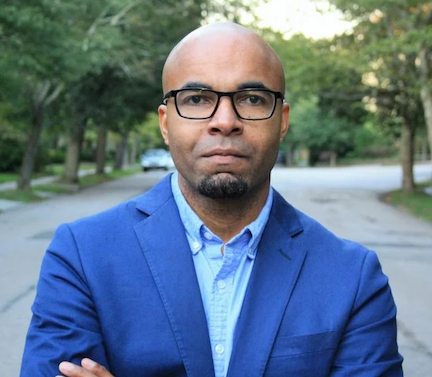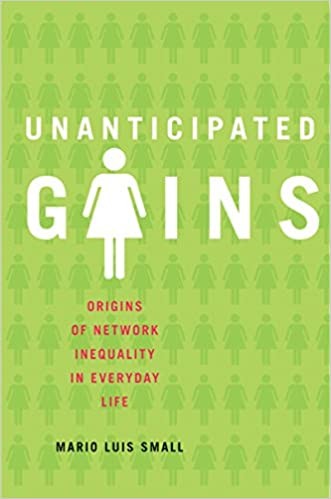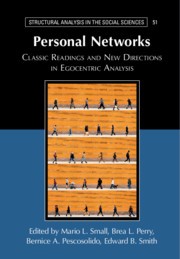Faculty Profile: Mario Small
Mario Small, Quetelet Professor of Social Science in the Department of Sociology, spoke with us about his research and about reacclimating himself to life in New York.
Can you speak about your background and your upbringing and what led to your interest in your current field?
I was born and raised in Panama City, Panama, and I came to the US to attend Carleton College in Minnesota. At first, I planned to be an engineer, because I liked math. After I started taking courses in other subjects, I came to really love social theory and decided to pursue a PhD in sociology at Harvard. When I first got there, I thought I just wanted to do social theory and more theoretically-oriented work, but I really started getting interested in empirical research—using data. Whether it was qualitative or quantitative data, large or small scale data, my interest had always been primarily idea-driven, and the data came later. It turns out that data has had a bigger impact on my career than I had thought.

I did an ethnographic study of a predominantly Puerto Rican housing complex in Boston. Villa Victoria was an interesting place because these weren't huge towers with impersonal buildings. These were essentially row houses, two or three stories high, which was new at the time. It was the product of a political mobilization by the residents who lived in the area before the complex was built.
During my last years in graduate school, I worked on a project for Professor William Julius Wilson, a noted expert on race and urban inequality in the US. He needed people to do ethnographic studies in cities and he hired me as one of his research assistants. During my time studying neighborhoods in Boston, I learned that a lot of people were using their childcare centers as neighborhood organizations, building networks among parents, not just children, and to gain access to things that you wouldn't even think of—like jobs. This was particularly happening in high-poverty neighborhoods in the city.
After I finished my first book, I decided to study network formation in childcare centers more seriously, and so I wrote a book called Unanticipated Gains, about how the networks of Black, Latina, and white mothers from various class backgrounds were shaped by the institutional organization of the childcare centers in which they enrolled their children.
Over the course of subsequent years, my work took a couple of different trajectories. One was very much about networks—how people decide whom to talk to when they need someone to talk to, the role of organizations and interpersonal networks, the importance of interpersonal interaction for the things that we can’t do online. And separately, I started getting very interested in space and racial inequality. Most recently, I wrote a paper in which we use Google Maps data to understand access to resources in neighborhoods of different racial composition.
There is an idea in social science today that neighborhoods matter to inequality—that it's not just your personal poverty or your professional background, but the conditions of the neighborhood where you grew up. It is not just the school, but the neighborhood itself that affects how you'll end up in life. Why? One of the reasons is the available resources, such as convenience stores and fresh foods in the supermarkets, banks that provide services, and so on. So, we wrote a study in which we examined accessibility of different kinds of establishments for neighborhoods of different racial composition.
We were looking at financial services; we wanted to know how accessible the nearest bank was relative to the nearest payday lenders or alternative financial institution from every block in major US cities. We calculated the number of minutes it would take to walk, to take public transit, or to drive from the middle of every block to the nearest bank relative to the nearest money lender or check casher in every block of the 20 largest cities in the country.
"...it's actually easier to bank conventionally in high poverty predominantly white neighborhoods than in middle class or affluent Black ones."
What we found was remarkable. We had assumed that we would see some racial differences, that predominantly African American blocks or neighborhoods were going to have an increased probability that the nearest payday lender is closer. I didn't expect that that relationship would hold, even after we took into account poverty level, homeownership level, education level, and physical infrastructure.
It turns out that the racial gradient is so strong that we can't make it disappear, and it remains quite robust. Put differently, it's actually easier to bank conventionally in high poverty predominantly white neighborhoods than in middle class or affluent Black ones. The probability that the nearest payday lender is faster to get to than the nearest bank is actually greater in upper-income African American neighborhoods. It’s a remarkable racial gradient.
That launched a series of studies we're doing right now, in which we're trying to understand racial inequality in access to financial services. We are looking at both the causes and the consequences for the people who live in these neighborhoods.
Is there any way to connect the benefits of the childcare center networks to this issue of inaccessible financial institutions?
It’s interesting; the research lines really proceeded sort of on their own, but it turns out that the project we're working on now is very much both about networks and about place. If you imagine the consequences of the racial inequality that I described earlier, then implicit in our model is the idea that if the payday lender is closer than the bank, then all else being equal, you're more likely to go to the lender. So, in a sense, we're assuming that the spatial distribution of resources in your neighborhood affects your decisions, particularly your financial decisions. So, rather than assume, we are trying to step back and understand how people actually make those decisions in the course of their lives. We have done some survey work and also some interviews to get a handle on this.
Here is an example from my own experience: when I was a professor at the University of Chicago, I lived in the South Loop on 18th street, which is literally 18 blocks from the center of downtown. The university was on 59th, again, south from the downtown. What's interesting about this is that the further south you go, the more of an African American neighborhood it is, and there you see many pockets of poverty.
At the time I needed to send money back to Panama because a relative had a serious illness. Just south of where I lived, on my route to work, I passed an alternate financial institution that said SEND MONEY INTERNATIONALLY. And so, for the first couple of years when I sent money, I literally just went there.
"After Black Lives Matter, people are using the term structural racism, and all of this sounds great, but there’s a lot of jargon and not a lot of clarity about exactly what we mean by structural racism: what’s the structure?"
After a while, my relative said that I should use a bank because it’s cheaper and just as fast. What's interesting is that I had a PhD, and at the time was dean of the University of Chicago’s social sciences division. I was not lacking for education, but the way I made the decision was really impacted by the ecology of resources around me. In this example, my network also played a role in changing my approach, because my relative back home influenced my decision.
We are trying to understand how the ecology of space plays a role, but also how networks play a role in these decisions. One of the things we've already discovered is that African Americans nationwide are more likely than whites nationwide to know somebody who has taken out a payday loan. As a result, there is an increased possibility that someone in their networks has done so.
So, it's partly a decision-making process, a spatial process, and a network process. racial inequality is implicated in all of this. After Black Lives Matter, people are using the term structural racism, and all of this sounds great, but there’s a lot of jargon and not a lot of clarity about exactly what the mean by structural racism: what’s the structure? This is a social science concept, but how does one observe it? How do I know that I'm seeing structural racism, as opposed to non-structural racism?
In this project, we're really trying to understand how spatial infrastructure can be racially graded in ways that influence the decision-making powers of any particular individual.
What are the bounds of a sociologist in this work? Is it in identifying trends, bringing issues to light, or something else?
I don't worry too much about the bounds of the sociologist, and that affects how I ask questions and who I collaborate with. In the first project I described, calculating the number of minutes to get to the nearest financial institution, I worked with urban planners and civil engineers who had the background in extracting data and who understand public infrastructure. The question is a fundamentally sociological question, but I didn't set limits according to what my training is or what my field understands. I look for others who can help fill in the gaps. This is about a decision-making process in which people are responding or not responding to what's physically in front of them—how people decide.
When I took my relative’s advice and went to the bank to send money, I paused the automatic, or what psychologists call system one thinking, and engaged in system two thinking, where I more deliberately thought about the options. For that kind of work, I might turn to colleagues in behavioral economics and psychology. Part of what I love about sociology is that anything you want counts. Sociologists do experiments and surveys; we spend a lot of time in the field; we download large-scale data sets and develop algorithms to analyze them; some do historical work, and I feel pretty fortunate in this field being able to do what I want, as long as I think it's interesting and important. Finding collaborators in other disciplines has been wonderful.
You have been speaking about the impact of place. What opportunities do you foresee in your work here in New York?
I was at Harvard for about seven years, and it is a fantastic institution with a lot of resources. I wanted things that Harvard just couldn’t provide. Some of it has to do with the intellectual, cultural, and political infrastructure of being an enormous city like New York. There are multiple universities here where researchers are working on similar issues—NYU, Princeton, and the CUNY Graduate Center. Then there's the city as a whole; I actually lived in Harlem the whole time I was at Princeton.
New York really has a diversity of exposure across class, across race and ethnicity, and across nationality, and this is important to the work that I do. A lot of the most important work in network analysis over the last 50 years has actually been done at Columbia. Paul Lazarsfeld developed some of the early measures for capturing people's networks that we still use today. He, along with Robert Merton, coined the term homophily, which refers to the fact that people and their networks tend to resemble their friends. Later years after that Harrison White developed probably the most important generation of network scholars for years. Peter Bearman, who is still in the department, worked on one of the most important surveys in the field. All of this influenced my decision to come here.
You have been here since January; what has it been like for you so far?
It's been fantastic. I’m teaching an undergraduate course on race and place in urban America, and it's been a great opportunity to connect with a diverse group of undergraduate students from all kinds of backgrounds. We really get into some pretty difficult, controversial issues: racial conflict, gentrification, and public housing; we're very much committed to tackling controversial topics head on. I am also teaching a graduate course on crafting empirical social science papers and we're reading across the gamut—papers from using experimental data, survey data, historical data, interview data, ethnographic data, and big data, and we’re reading sociology, political science, economics, and psychology. We have an expansive understanding of the sciences, and it’s fun to connect with the graduate students in a very different way.
The faculty have been fantastic as well. I have been slowly going down the list of all of the faculty who have reached out to meet. This is a very dynamic place with a lot of energy. It is a place where people like to hustle and that really fits my personality, so it’s a really good fit.
Is there anything else you’d like to mention?
We just produced a major volume on personal networks with 50 contributors and 750 pages and it speaks to the tradition that Columbia University helped develop. I'm doing a new book in the fall on how to evaluate qualitative methods. That project is that it has a different connection to Columbia; Nicholas Lemann, the former dean of the Columbia Journalism School, is very serious about having his students exposed to data and thinking about it the way a social scientist would. I visited his class several times over the last few years, and he was one of the people who convinced me that I should write this book.
To learn more about Dr. Small's research, please visit his faculty website or you may email him directly.

